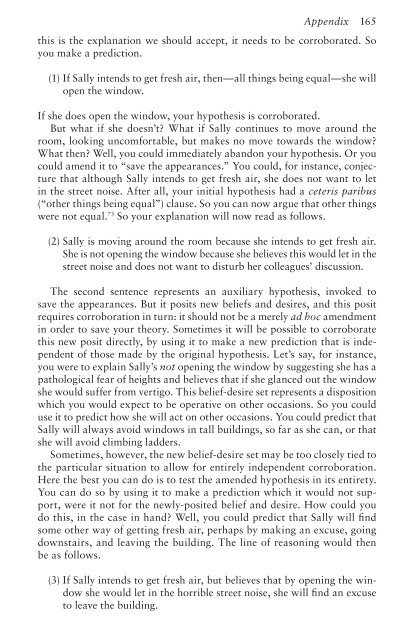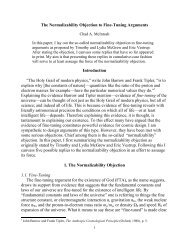Theism and Explanation - Appeared-to-Blogly
Theism and Explanation - Appeared-to-Blogly
Theism and Explanation - Appeared-to-Blogly
Create successful ePaper yourself
Turn your PDF publications into a flip-book with our unique Google optimized e-Paper software.
Appendix 165<br />
this is the explanation we should accept, it needs <strong>to</strong> be corroborated. So<br />
you make a prediction.<br />
(1) If Sally intends <strong>to</strong> get fresh air, then—all things being equal—she will<br />
open the window.<br />
If she does open the window, your hypothesis is corroborated.<br />
But what if she doesn’t? What if Sally continues <strong>to</strong> move around the<br />
room, looking uncomfortable, but makes no move <strong>to</strong>wards the window?<br />
What then? Well, you could immediately ab<strong>and</strong>on your hypothesis. Or you<br />
could amend it <strong>to</strong> “save the appearances.” You could, for instance, conjecture<br />
that although Sally intends <strong>to</strong> get fresh air, she does not want <strong>to</strong> let<br />
in the street noise. After all, your initial hypothesis had a ceteris paribus<br />
(“other things being equal”) clause. So you can now argue that other things<br />
were not equal. 73 So your explanation will now read as follows.<br />
(2) Sally is moving around the room because she intends <strong>to</strong> get fresh air.<br />
She is not opening the window because she believes this would let in the<br />
street noise <strong>and</strong> does not want <strong>to</strong> disturb her colleagues’ discussion.<br />
The second sentence represents an auxiliary hypothesis, invoked <strong>to</strong><br />
save the appearances. But it posits new beliefs <strong>and</strong> desires, <strong>and</strong> this posit<br />
requires corroboration in turn: it should not be a merely ad hoc amendment<br />
in order <strong>to</strong> save your theory. Sometimes it will be possible <strong>to</strong> corroborate<br />
this new posit directly, by using it <strong>to</strong> make a new prediction that is independent<br />
of those made by the original hypothesis. Let’s say, for instance,<br />
you were <strong>to</strong> explain Sally’s not opening the window by suggesting she has a<br />
pathological fear of heights <strong>and</strong> believes that if she glanced out the window<br />
she would suffer from vertigo. This belief-desire set represents a disposition<br />
which you would expect <strong>to</strong> be operative on other occasions. So you could<br />
use it <strong>to</strong> predict how she will act on other occasions. You could predict that<br />
Sally will always avoid windows in tall buildings, so far as she can, or that<br />
she will avoid climbing ladders.<br />
Sometimes, however, the new belief-desire set may be <strong>to</strong>o closely tied <strong>to</strong><br />
the particular situation <strong>to</strong> allow for entirely independent corroboration.<br />
Here the best you can do is <strong>to</strong> test the amended hypothesis in its entirety.<br />
You can do so by using it <strong>to</strong> make a prediction which it would not support,<br />
were it not for the newly-posited belief <strong>and</strong> desire. How could you<br />
do this, in the case in h<strong>and</strong>? Well, you could predict that Sally will fi nd<br />
some other way of getting fresh air, perhaps by making an excuse, going<br />
downstairs, <strong>and</strong> leaving the building. The line of reasoning would then<br />
be as follows.<br />
(3) If Sally intends <strong>to</strong> get fresh air, but believes that by opening the window<br />
she would let in the horrible street noise, she will fi nd an excuse<br />
<strong>to</strong> leave the building.



